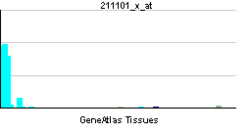LILRA2
Leukocyte immunoglobulin-like receptor subfamily A member 2 is a protein that in humans is encoded by the LILRA2 gene.[1][2][3]
Leukocyte Ig-like receptors (LIRs) are a family of immunoreceptors expressed predominantly on monocytes and B cells and at lower levels on dendritic cells and natural killer (NK) cells. All LIRs in subfamily B have an inhibitory function (see, e.g., LILRB1, MIM 604811). LIRs in subfamily A, with short cytoplasmic domains lacking an immunoreceptor tyrosine-based inhibitory motif (ITIM) and with transmembrane regions containing a charged arginine residue, may initiate stimulatory cascades. One member of subfamily A (LILRA3; MIM 604818) lacks a transmembrane region and is presumed to be a soluble receptor.[supplied by OMIM][3]
See also
References
Further reading
- Maruyama K, Sugano S (1994). "Oligo-capping: a simple method to replace the cap structure of eukaryotic mRNAs with oligoribonucleotides.". Gene 138 (1-2): 171–4. doi:10.1016/0378-1119(94)90802-8. PMID 8125298.
- Rojo S, Burshtyn DN, Long EO, Wagtmann N (1997). "Type I transmembrane receptor with inhibitory function in mouse mast cells and NK cells.". J. Immunol. 158 (1): 9–12. PMID 8977169.
- Suzuki Y, Yoshitomo-Nakagawa K, Maruyama K et al. (1997). "Construction and characterization of a full length-enriched and a 5'-end-enriched cDNA library.". Gene 200 (1-2): 149–56. doi:10.1016/S0378-1119(97)00411-3. PMID 9373149.
- Strausberg RL, Feingold EA, Grouse LH et al. (2003). "Generation and initial analysis of more than 15,000 full-length human and mouse cDNA sequences.". Proc. Natl. Acad. Sci. U.S.A. 99 (26): 16899–903. doi:10.1073/pnas.242603899. PMC 139241. PMID 12477932.
- Tedla N, Bandeira-Melo C, Tassinari P et al. (2003). "Activation of human eosinophils through leukocyte immunoglobulin-like receptor 7.". Proc. Natl. Acad. Sci. U.S.A. 100 (3): 1174–9. doi:10.1073/pnas.0337567100. PMC 298746. PMID 12529506.
- Nakajima H, Asai A, Okada A et al. (2004). "Transcriptional regulation of ILT family receptors.". J. Immunol. 171 (12): 6611–20. doi:10.4049/jimmunol.171.12.6611. PMID 14662864.
- Sloane DE, Tedla N, Awoniyi M et al. (2004). "Leukocyte immunoglobulin-like receptors: novel innate receptors for human basophil activation and inhibition.". Blood 104 (9): 2832–9. doi:10.1182/blood-2004-01-0268. PMID 15242876.
- Gerhard DS, Wagner L, Feingold EA et al. (2004). "The status, quality, and expansion of the NIH full-length cDNA project: the Mammalian Gene Collection (MGC).". Genome Res. 14 (10B): 2121–7. doi:10.1101/gr.2596504. PMC 528928. PMID 15489334.
External links
This article incorporates text from the United States National Library of Medicine, which is in the public domain.
|
|---|
| | 1-50 | |
|---|
| | 51-100 | |
|---|
| | 101-150 | |
|---|
| | 151-200 | |
|---|
| | 201-250 | |
|---|
| | 251-300 | |
|---|
| | 301-350 | |
|---|
|


